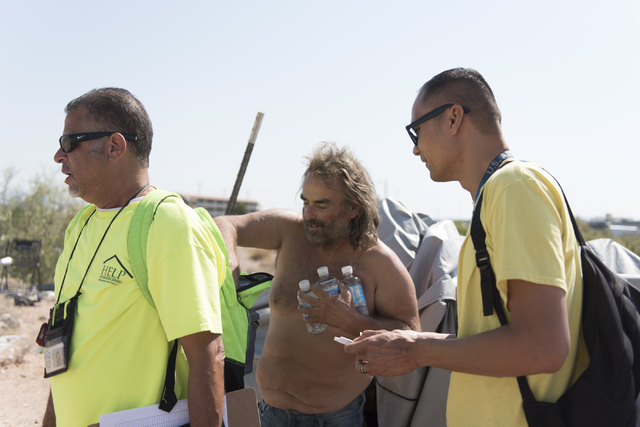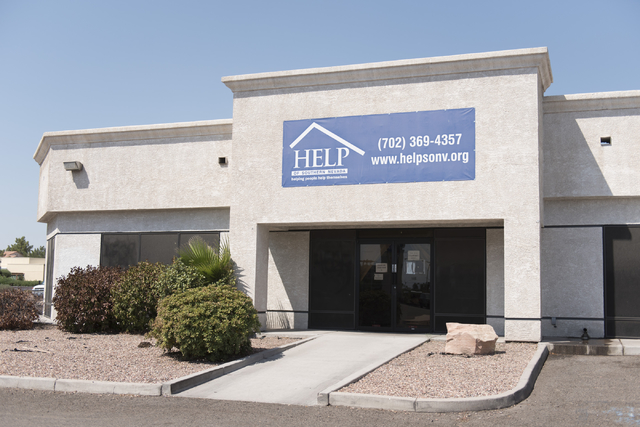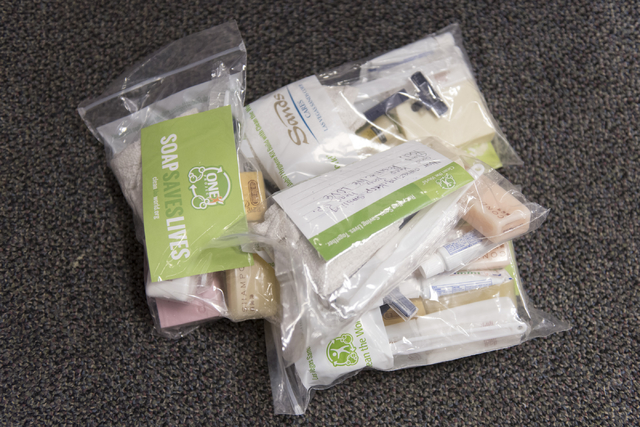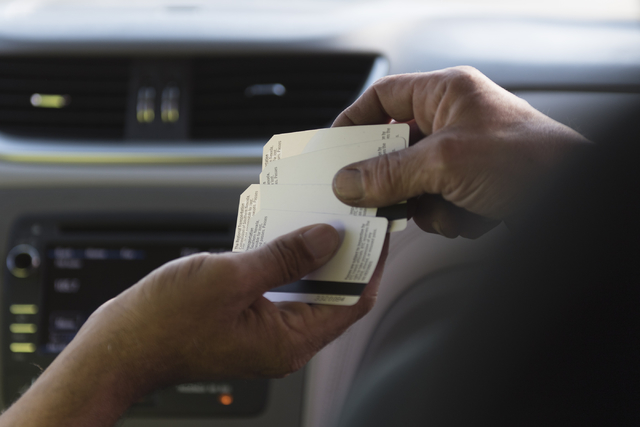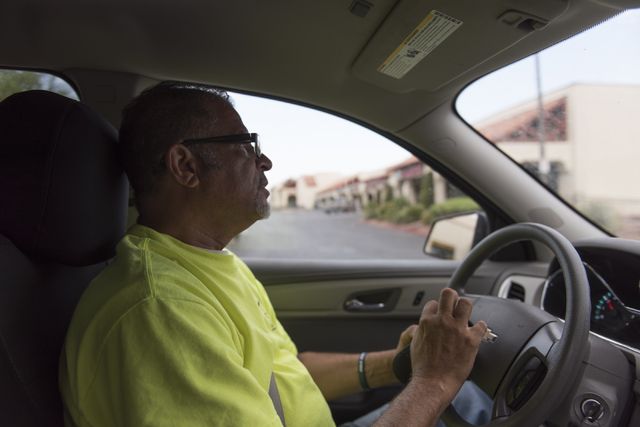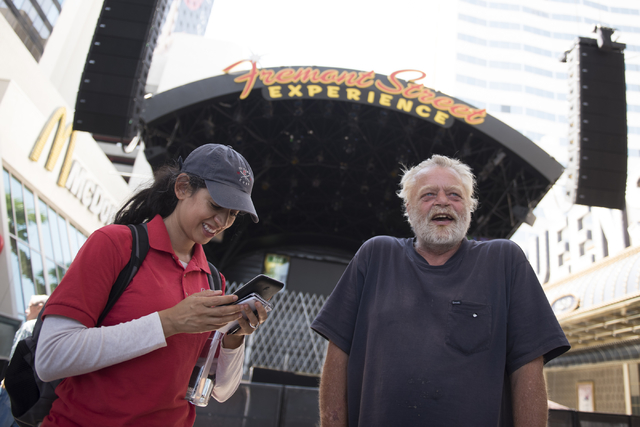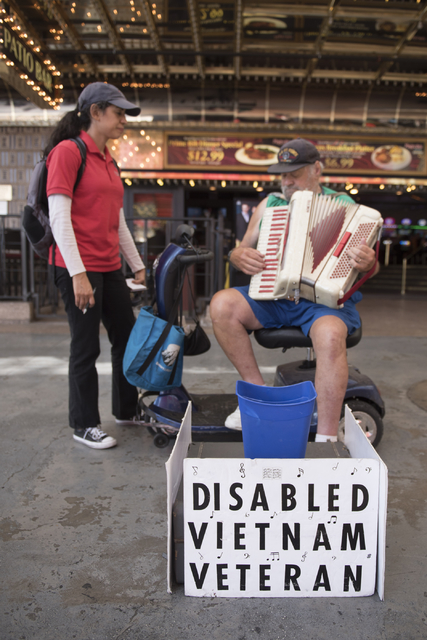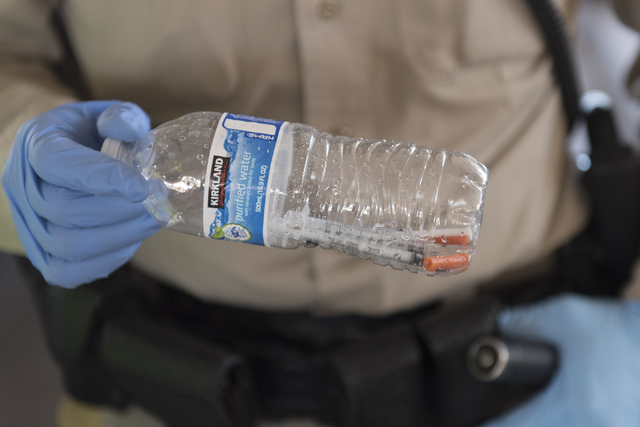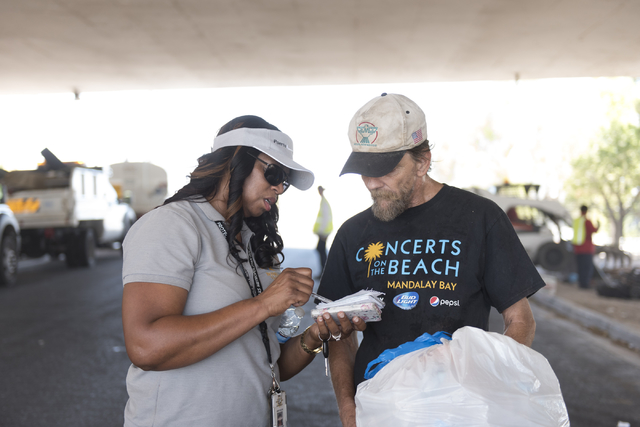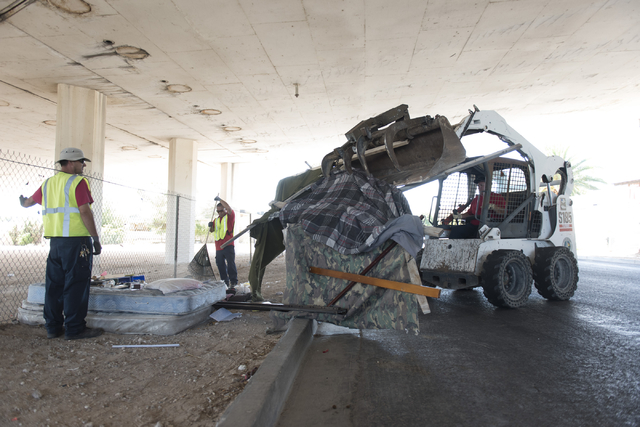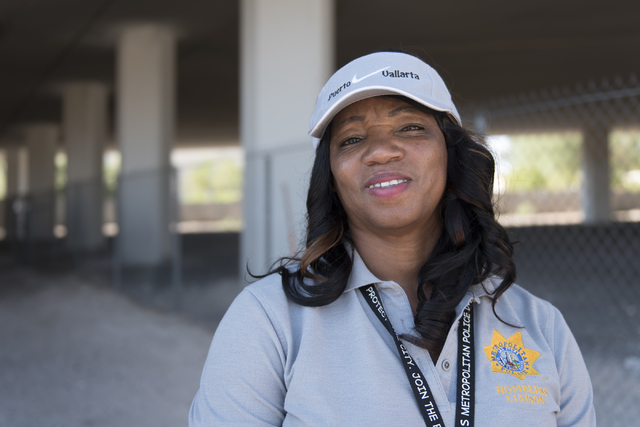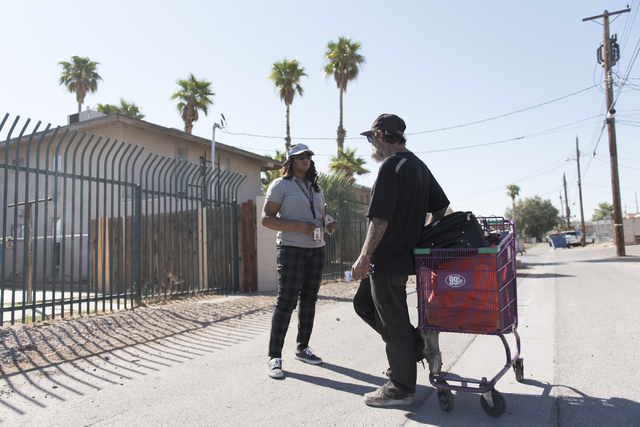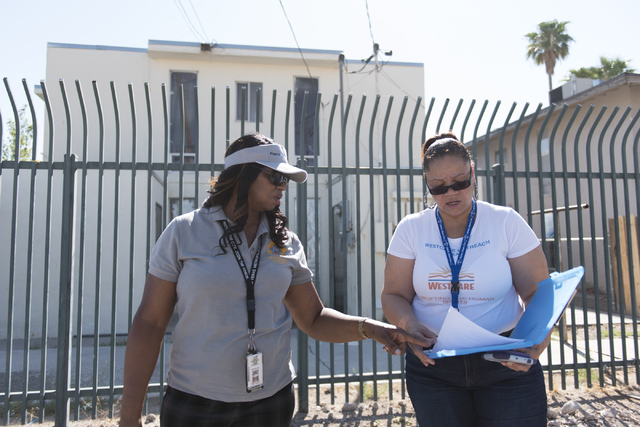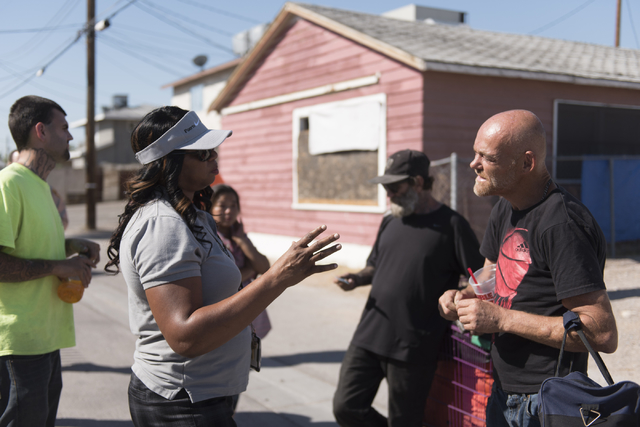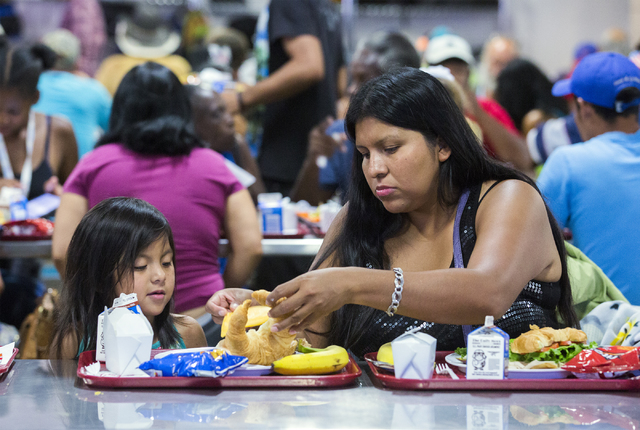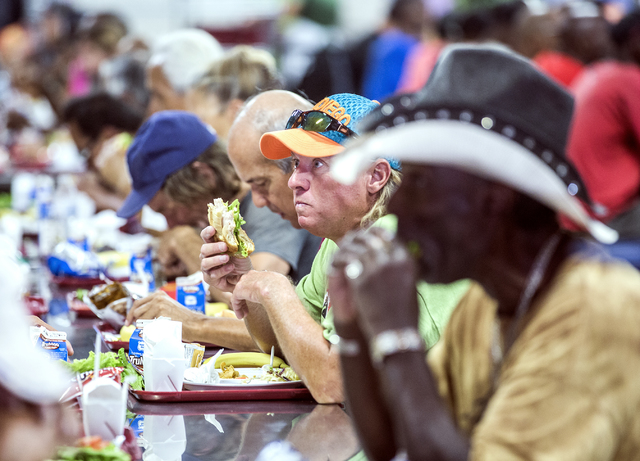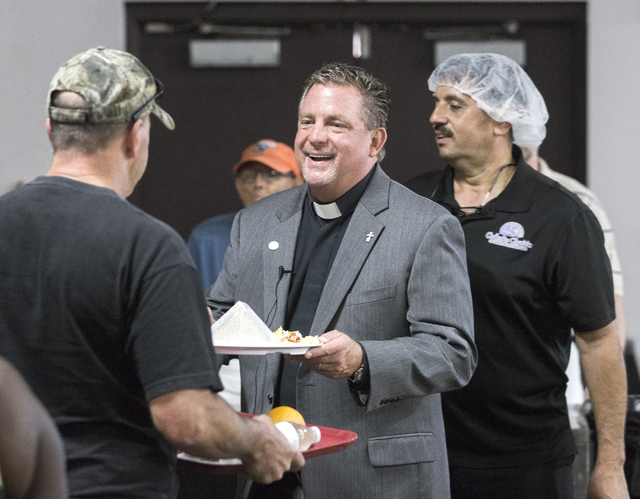Outreach efforts all about taking help to Las Vegas homeless
Hiding in plain sight, thousands of homeless people frequent desert lots, restaurant alleyways, storm drains under casinos and the sidewalks all over the valley.
Some people won’t give them a second glance or simply don’t acknowledge their presence, but there are people who have made it their mission to see the unseen.
“People always wonder what I’m doing when I’m scanning the desert,” said Lou Lacey, the manager for the Mobile Crisis Intervention Team with HELP of Southern Nevada. “I’m looking.”
Passing by a stretch of desert on Dean Martin Drive near Blue Diamond Road, Lacey sees a single tent in the back and knows he will be checking it out at some point.
Even if he is off work, he will make a mental note of an encampment and come back later.
He is looking because he knows these people can be reached and connected to services that will give them a better chance of making changes.
Outreach to the city’s homeless isn’t just work. It’s a calling.
“We are brokers of services,” he said. “We break down barriers to get people to the services they need.”
MAKING CONTACT
At HELP of Southern Nevada, Lacey is known as “the captain.” He sends out outreach coordinators with the nonprofit throughout the day all over the valley to work with people.
Armed with a tablet and a backpack full of water bottles and bus passes, Lacey goes to where his clients are to see what they need whether it’s the tunnels under the Strip or the bathroom of Sunset Park.
Each client has a different need. Some are ready to make a step toward getting housing or need help getting a new driver’s license, while others need mental health treatment or drug rehabilitation.
“We offer wrap-around services,” Lacey said.
No two days are the same.
One morning before leaving the office around 7 a.m., Lacey plans to head downtown. Three hours and many detours later, he has talked with five guys — some new, some regulars — and has yet to make it to his original destination.
“That’s the story of the day,” he said. “It never goes as planned.”
The morning he sees the tent in the desert, he finds not one but three men — one who he has never met, another who he has and the last who is fine being left alone.
For the first guy, he begins collecting information and starts working to get him off the streets.
While Lacey goes all over the county, Merideth Spriggs, the founder of the nonprofit Caridad, focuses her outreach on the Fremont area.
“Welcome to my office,” she said as she entered the canopy.
Every day — sometimes in the morning, sometimes in the afternoon — she walks up and down Fremont Street and the surrounding side streets meeting with people along the way. For the most part, she has seen all the same faces before.
On any given day, she helps them obtain identification and birth certificates, distributes bus passes, disseminates mail and follows up on where a client is in the quest to find housing.
One of her clients asked if he could grab him a coffee — he had the money but the casinos won’t let him in.
For every four or five regular clients, she sees a new face.
“I usually go up and introduce myself,” she said.
She also goes through a flurry of questions: how long have you been homeless, where are you staying, do you have any health needs?
“I might not offer services my first time meeting with them” she said. “This is about establishing a relationship.”
For the clients who have met goals, whether it’s finally obtaining proper identification or applying for social security, Spriggs offered to buy them a reward. “I call them slurpees for success,” she said.
Spriggs thinks outreach services should be approached the same way as concierge and VIP services approach clients at nightclubs
It might take more than one attempt and it might be a long road, but if the coordinators are willing to stick with their clients from beginning to end, they have seen more success.
While many of the homeless in Las Vegas might encounter people like Spriggs or Lacey, sometimes they run into law enforcement first.
That’s why Annie Wilson, the homeless liaison with Las Vegas Metropolitan Police Department, is making training part of her mission.
Throughout the week, Wilson is also organizing outreach with different area commands where she takes officers out with her to meet with people and see what services they need.
It might be proper clothes for a job interview. It could be finally having the desire to get off the streets into housing.
“You gotta meet the people where they are at,” she said. “Our goal is to eliminate any barrier that is in their way to getting services.”
COOPERATIVE OUTREACH
On a Wednesday morning during a joint outreach between Metro, Caridad, HELP of Southern Nevada and U.S. Vets, Wilson has stumbled across a 26-year-old woman sleeping behind Caesars Palace.
Originally from China, the woman moved to Las Vegas about a year ago with no plan. Her Green Card has since expired.
“We can’t just leave her out here,” Wilson said.
She calls over the Catholic Charities to check on their immigration services and then arranges for her to stay the week at Las Vegas Rescue Mission along with another woman who approached the outreach workers for help.
Wilson is just one person, which is why she is training officers about how to work with people experiencing homelessness.
“We are teaching (the officers) to help them understand why people might be homeless,” she said.
Officers also join up with outreach coordinators to go out and help connect people with services. Instead of having an enforcement-first mentality, working with Wilson and the other workers has allowed them to be a resource for many of the homeless they come across.
As they walk up and down the Strip with Wilson and Spriggs, people stop to ask questions about getting connected to resources.
Homeless people are scattered throughout the valley, but there are a few places that draw them in.
Lines of people converge on Catholic Charities of Southern Nevada for a morning meal.
Deacon Tom Roberts, the CEO of Catholic Charities of Southern Nevada, said anywhere between 500 and 1,000 people come through the cafeteria each day to receive a free meal.
“We see more toward the end of the month,” he said.
On the campus, Catholic Charities also has a homeless shelter open to men each night.
“On average, we have more than 500 men every single night,” he added. “It’s fresh linens and a place to rest safely.”
Roberts said since they are only equipped to house men, the women the work with usually stay at The Shade Tree.
Marlene Richter, executive director of The Shade Tree, said the organization shelters about 300 new homeless women per month.
“We also bring in the homeless that don’t want shelter during the day to let them shower, eat, work on solutions and hopefully ask about coming into shelter because we have gained their trust,” said.
THE NEXT STEP
Roberts said Catholic Charities looks beyond a daily meal and place to stay.
When they are ready for a change, there is also a work program called resident empowerment program that helps those interested start the process toward self-sufficiency.
He added candidates get one-on-one case management and learn job and life skills.
While each agency and person spends time working with clients independently, this issue doesn’t exist in a vacuum, which is why the Nevada Homeless Alliance exists.
Though Emily Paulsen is new as the executive director to the Nevada Homeless Alliance, she carries on its vision to help connect service providers, government agencies and faith-based communities in the mission to end homelessness in Clark County.
Throughout the year, the alliance is partnering with Las Vegas-based people and agencies to make sure outreach workers are better connected.
Nevada Homeless Alliance also organizes two events each year, its largest being Project Homeless Connect. The event partners with about 150 agencies offering a variety of services from mental health, welfare and court assistance to offering haircuts and dental care.
More than 3,000 people come through the event.
“I hope we can put on more than one Project Homeless Connect each year,” she said.
“Not one agency can do this alone,” Wilson said. “It’s all about collaboration. That’s how we make a difference.”
To reach Henderson View reporter Michael Lyle, email mlyle@viewnews.com or call 702-387-5201. Folow @mjlyle on Twitter.
SIDEBAR IS NOW: HOMELESS HELPERS-OCT09-16




